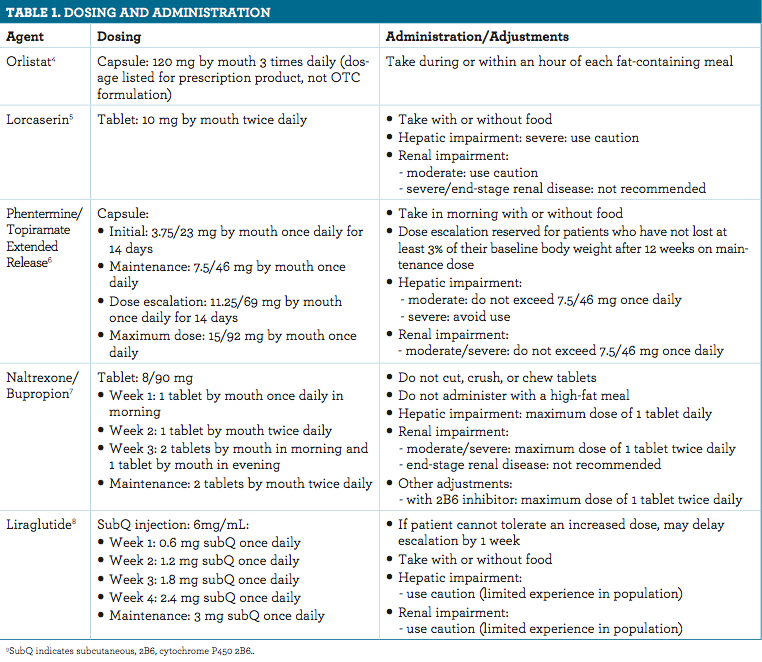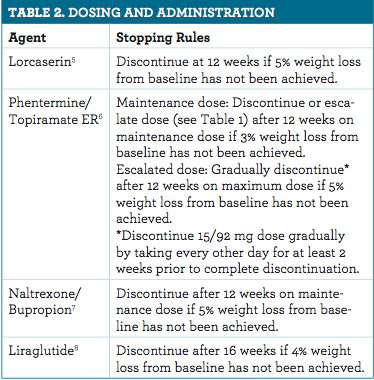Publication
Article
Pharmacy Practice in Focus: Health Systems
The Skinny on Weight-Loss Medications
Author(s):
Despite the availability of such products, obesity continues to signifi- cantly contribute to morbidity and mortality in the United States.
INTRODUCTION
The prevalence of obesity is at an all-time high, with 30.4% of US adults classified as obese, defined as a body mass index (BMI) ≥30kg/m2. As of 2015, no US state or territory had an obesity rate of less than 20%, and it was at least 35% in 4 states: Alabama, Louisiana, Mississippi, and West Virginia.1-3 Over the past 5 years, there has been an emergence of several prescription options to treat the condition. Despite the availability of such products, obesity continues to significantly contribute to morbidity and mortality in the United States.
The following are prescription options to treat obesity:
• Orlistat (Xenical, Genentech) reversibly inhibits gastrointestinal lipase, preventing dietary fat digestion and absorption and leading to a calorie deficit.4
• Lorcaserin (Belviq, Arena Pharmaceuticals) is thought to decrease dietary consumption and promote satiety via selective serotonin 2C receptor agonism.5
• Phentermine/Topiramate Extended-Release (Qsymia, Vivus, Inc) is thought to sup- press appetite via action of phentermine, a sympathomimetic amine, and topiramate’s pharmacologic activity (gamma-aminobu- tyrate augmentation, glutamate inhibition, and others).6
• Naltrexone/Bupropion (Contrave, Orexigen Therapeutics, Inc) contains an opioid antagonist, naltrexone, and a weak dopamine/norepinephrine reuptake inhibitor, bupropion. Both components are thought to interact with the areas of the brain responsible for the regulation of appetite and the reward pathway.7
• Liraglutide (Saxenda, Novo Nordisk), a glucagon-like peptide-1 (GLP-1) receptor agonist, regulates appetite in a similar fash- ion as endogenous GLP-1 does.8
THERAPEUTIC USE, DOSING, AND ADMINISTRATION
All 5 chronic weight-loss pharmacotherapies are indicated for use in adults with a BMI ≥30kg/m2 or ≥27kg/m2, with at least 1 weight-related comorbidity/risk factor such as diabetes (type 2), dyslipidemia, or hypertension. These agents are meant to be used as an adjunct to diet and exercise. See table 14-8 for dosing and administration recommendations for each medication. Because some patients may not respond to a given therapeutic option, the newest medications include guidance regarding agent discontinuation (table 25-8).


ADVERSE REACTIONS (FDA DRUG WARNINGS)Naltrexone/Bupropion
This carries a boxed warning for an increased risk of suicidal thinking and behavior as well as for the occurrence of serious neuropsychiatric events.7 These warnings are based on the use of bupropion in children, for the treatment of major depression or psychiatric disorders, and for smoking cessation. Although naltrexone/bupropion is not approved for these indications, patients taking it should be monitored for suicidal thoughts/behaviors and neuropsychiatric reactions.
Liraglutide
This carries a boxed warning for thyroid C-cell tumors based on the incidence of such tumors in animal studies.8 It is not known whether this risk translates to humans. Therefore, this agent is contraindicated in patients with a personal or family history of medullary thyroid carcinoma and in patients with multiple endocrine neoplasia syndrome type 2. Common (≥5%) adverse reactions are listed in table 3.4-8
DRUG INTERACTIONS
Common drug interactions for each agent are listed below. See individual prescribing information for details regarding coadministration of the implicated medications. Additionally, naltrexone/bupropion can cause a false-positive urinalysis for amphetamines.
Orlistat
These include amiodarone, antiepileptics, antiretrovirals, cyclosporine, fat-soluble vitamins, levothyroxine, and warfarin.4
Lorcaserin
These include serotonergic agents, such as bupropion, dextromethorphan, monoamine oxidase inhibitors (MAOIs), selective serotonin reuptake inhibitors, serotonin-norepinephrine reuptake inhibitors, St John’s wort, and triptans.5
Phentermine/Topiramate ER
These include central nervous system depressants, non-potassium sparing diuretics, and oral contraceptives.6
Naltrexone/Bupropion
These include agents that lower seizure threshold, amantadine, the CYP2B6 gene inducers/inhibitors, CYP2D6 gene substrates, levodopa, and MAOIs.7
Liraglutide
These include concomitantly administered oral medications due to gastric emptying delay.8
CLINICAL EFFICACY
Medication approval trials for orlistat, lorcaserin, phentermine/ topiramate ER, naltrexone/bupropion, and liraglutide demonstrated weight loss ≥5% from the baseline in 37.5% to 70% of participants at 52 to 56 weeks.4-8 Additional studies have been undertaken, and a 2016 systematic review and meta-analysis concluded that all agents demonstrated at least 5% weight loss at 52 weeks compared with the placebo.10 Of the 5 agents, participants treated with phentermine/topiramate ER or liraglutide were most likely to achieve this percentage weight loss.
PLACE IN THERAPY
Overweight/obesity guidelines have been released by the American Heart Association/American College of Cardiology/ The Obesity Society, the Endocrine Society, and the American Association of Clinical Endocrinologists/American College of Endocrinology over the past 3 years.3 All guideline documents recommend routine patient screening, lifestyle modifications, and pharmacologic therapy initiation based on BMI and the presence of comorbidities per approved therapeutic indication.11,12
CONCLUSION
With the growing prevalence of obesity and increasing availability of pharmacotherapies, more focus is needed on this condition. Right now, no chronic obesity agent is preferred. Instead, an emphasis is placed on individualizing therapy to a patient’s needs.
Erin E. Pauling, PharmD, is a clinical assistant professor of ambulatory care at Binghamton University School of Pharmacy and Pharmaceutical Sciences.
References
- CDC. Adult obesity prevalence maps. cdc.gov/obesity/data/prevalence-maps.html. Updated April 10, 2017. Accessed August 15, 2017.
- CDC. National Health Interview Survey. cdc.gov/nchs/nhis.htm. Updated August 14, 2017. Accessed August 15, 2017.
- Jensen MD, Ryan DH, Apovian CM, et al. 2013 AHA/ACC/TOS guideline for the management of overweight and obesity in adults: a report of the American College of Cardiology/American Heart Association Task Force on Practice Guidelines and The Obesity Society. Circulation. 2014;(25 Suppl 2):S102-138. doi: 10.1161/01.cir.0000437739.71477.ee.
- Xenical [prescribing information]. South San Francisco, CA: Genentech USA Inc; 2016. www.gene.com/download/pdf/xenical_prescribing.pdf. Accessed August 15, 2017.
- Belviq [prescribing information]. Zofingen, Switzerland: Arena Pharmaceuticals GmbH; 2014. belviq.com/-/media/Files/BelviqConsolidation/PDF/belviqxr_prescribing_information-pdf.pdf. Accessed August 15, 2017.
- Qsymia [prescribing information]. Mountain View, CA: Vivus Inc; 2014. qsymia.com/pdf/prescribing-information.pdf. Accessed August 15, 2017.
- Contrave [prescribing information]. La Jolla, CA: Orexigen Therapeutics Inc; 2014. accessdata.fda.gov/drugsatfda_docs/label/2014/200063s000lbl.pdf. Accessed August 15, 2017.
- Saxenda [prescribing information]. Plainsboro, NJ: Novo Nordisk Inc; 2014. accessdata.fda.gov/drugsatfda_docs/label/2014/206321Orig1s000lbl.pdf. Accessed August 15, 2017.
- U.S. FDA approves Belviq XR®, a once-daily formulation of lorcaserin for chronic weight management [news release]. Tokyo: Eisai, Co, Ltd; July 19, 2016. eisai.com/news/enews201652pdf.pdf. Accessed September 30, 2016.
- Khera R, Murah MH, Chandar AK, et al. Association of pharmacological treatments for obesity with weight loss and adverse events: a systematic review and meta-analysis. JAMA. 2016;315(22):2424-2434. doi: 10.1001/jama.2016.7602.
- Apovian CM, Aronne LJ, Bessesen DH, et al. Pharmacological management of obesity: an Endocrine Society clinical practice guideline. J Clin Endocrinol Metab. 2015;100(2):342-362. doi: 10.1210/jc.2014-3415.
- Garvey WT, Mechanick JI, Brett EM, et al. American Association of Clinical Endocrinologists and American College of Endocrinology comprehensive clinical practice guidelines for medical care of patients with obesity. Endocr Pract. 2016;22(suppl 3):1-203. doi: 10.4158/EP161365.







